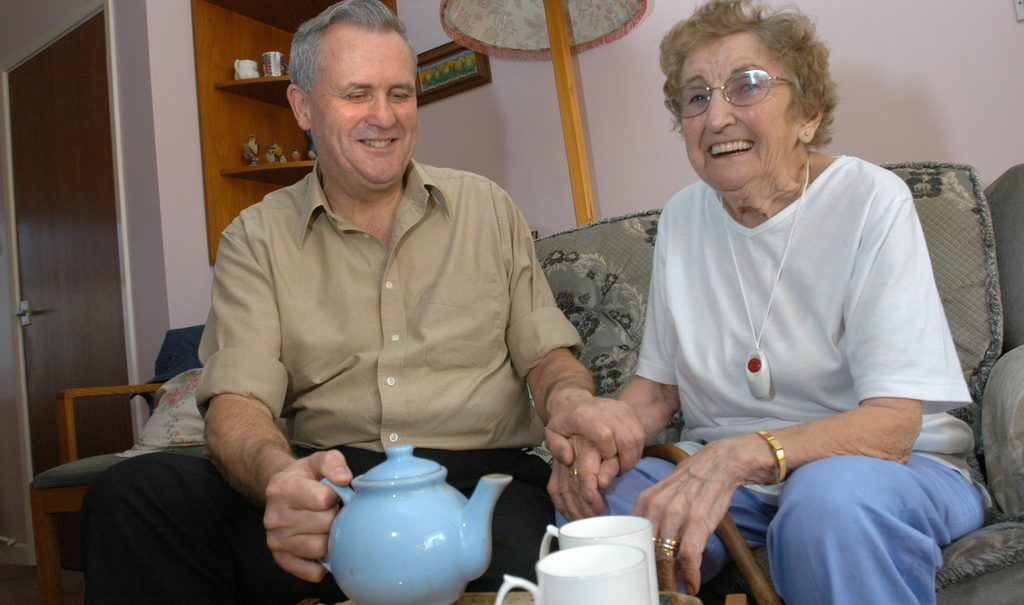Why we need a new national care service

Maisie Palmer, who uses British Red Cross ‘Care in the Home’ initiative. Photo: British Red Cross. Flickr. Creative Commons
In 2017, the Labour party manifesto pledged to lay the foundations of a national care service – repeating commitments hinted at prior to previous elections. This comes at a time when experts are increasingly warning of a social care system in “crisis”. Real-terms funding has fallen despite an ageing population creating greater demand, and when the government eventually caved into enormous pressure to release more money, it provided only a small fraction of what is needed – £2 billion over three years, when more than that is needed in this year alone. But the crisis is not just one of funding. It is deep and systemic – but I believe that the “tipping point” experts say we have now reached is an opportunity to take stock and build something more sustainable, resilient and just than the failing system we have today.
The social care problem is three-fold:
- Decreasing resource at a time of increasing need. This is the funding problem.
- The fact that healthcare and social care and separate services despite serving those with the same needs. Healthcare is free at the point of use, whereas social care is heavily means- and needs-tested. This is the integration problem.
- You don’t hear much about the third dimension. Social care services are delivered by private providers in a marketplace, but this market has failed. This is the marketisation problem.
I’m going to tackle these three areas individually, but first, let’s take a look at the social care system itself.
The social care system
Unlike healthcare, social care is commissioned by local authorities (LAs), and usually provided by private agencies. Unlike our free-at-the-point-of-use NHS, subsidised care is heavily means- and needs-tested. To confuse matters further, the NHS runs a service called Continuing Healthcare – those who meet the criteria have their fees fully paid without means testing. About half of care users have all their fees paid by the LA or the NHS, and around 41% pay for their own care. The rest get some help towards their fees. Social care is paid for out of council tax and business rates, as well as central government grants such as the Revenue Support Grant.
I’m going to tackle three problems individually, but I should point out that all three are interrelated, part and parcel of the same systemic issues.
The funding problem
Fewer and fewer people are receiving the care they need. Money going into the system is dropping in real terms, even though the need is increasing as our population ages. The number of people aged 85+ grew by almost a quarter between 2001 and 2011, but according to Age UK, the number of people receiving care fell from 1.2 million in 2005/6 to 850,000 in 2013/4. According to the regulatory body for social care, the Care Quality Commission (CQC), real-terms funding was 1.5% lower in 2015/16 than it was ten years earlier, despite the ageing population. More and more, care is limited to those with the highest need, and to the minimum required.
The funding situation is set to get worse. The government is phasing out its Revenue Support Grant (RSG) to councils as it hands over 100% discretion over business rate spending to LAs in 2019/20. The government argues that this will enable councils to meet their social care spending needs, in combination with the Social Care Precept, which gives LAs discretion to raise council tax above centrally capped levels for the express purpose of spending the proceeds on social care. But organisations like the Association of Directors of Adult Social Services (ADASS) points out that this will create greater care inequality, since the areas most in need of social care are poorer ones where less money is raised through local taxation.
Funding cuts mean councils limit services to those with the highest need, and to the minimum required – often less than that. Cuts impact care workers’ pay. Median pay for care workers stood at £7.76 per hour in 2017. In residential care, it is estimated that between 160,000 and 220,000 care workers earn less than the national minimum wage. According to Skills for Care, registered nurses working in social care in 2015 were paid a mean annual salary of £25,000 – much less than their counterparts in the NHS, and without the same scope for careers progression.
Training is woeful as well. No formal qualifications are required to work in social care – making decent training all the more important. According to UNISON, over a quarter of care workers receive no dementia training, and less than a quarter of those who administer medicines are trained to do so. No wonder turnover is high, with almost a half of care workers leaving within a year in 2015, and over a third of nurses quitting the sector. Poor training and high turnover and vacancy rates have a knock-on effect on the quality of services on offer.
The integration problem
Because health and social care are separate services, many people experience a bumpy transition from hospital to homecare. Bed delays increased by almost a third between 2013 and 2015, costing the NHS about £820 billion a year, according to the National Audit Office. Largely, this was because there was no one available to provide adequate care to these patients at home.
The NHS and social care spend a lot of time and money disputing who has responsibility for the patient, because neither wants to bear the cost. This often has tragic consequences – as Ray’s case illustrates. His daughter Sally-Ann tells Ray’s story, picking up the story at the point of discharge from hospital: “He could not be left unsupervised as he was unable to do anything for himself. He was at risk of malnutrition, dehydration and pressure sores and prone to recurrent infections. None of this seemed to be defined as a health need, and it took five weeks to reach a decision about whether he was entitled to NHS Continuing Healthcare as health and social care fought over who should pay. Where was the person in all of this?”
Ray’s application to NHS Continuing Healthcare was declined. This meant the care team he and his family had become familiar with had to change, and suddenly the family had to bear the cost, which ran to a four-figure monthly sum. The community nursing team attempted a last-ditch application for NHS Continuing Healthcare, but it was turned down just 24 hours before Ray died. Sally-Ann says, “What I now ask is: why should anyone at the end of their life have to pay for their own care to die at home?”
The marketisation problem
Since the 1990 NHS and Community Care Act, the system has been run on a marketised model where care is delivered by private providers. Prior to this, LAs generally provided care themselves, but the Act recast them as “enabling authorities”. To ensure this happened, funding from central government came with the requirement that 85% of money should be spent on the purchase of care services from the private sector.
If the motive behind marketisation was the idea that a competitive marketplace would incentivise high quality at low cost, then the market has failed spectacularly. Instead of a competitive, dynamic marketplace, we have one made up of a few large providers. According to the Professor Bob Hudson in a paper for the CHPI thinktank, the 10 largest providers account for 20% of the market, the largest 20 make up 28%. In this climate of austerity-driven fee-squeezing by councils, the system has become precarious as business becomes increasingly untenable for providers. Southern Cross, which collapsed due to financial hardship in 2011, was responsible for almost a tenth (9%) of the national market, and up to 30% in some areas. There is no back-up plan to protect services should providers withdraw.
The Southern Cross example shows that the market is not only “inefficient”, to use Professor Hudson’s term, but also unstable. The government says in its guidance to the 2014 Care Act that “high-quality, personalised care and support can only be achieved where there is a vibrant, responsive market of service providers”, but places the burden of creating such a marketplace on local government at a time when a lack of funds has put it in “panic mode” (as put by Alex Fox of Shares Lives Plus), with no appetite for creating such a marketplace.
Instead, price has become the driving consideration for LAs when choosing a provider, rather than a balance between cost and service quality. This in turn encourages some providers to put in unrealistically low bids which result in poor-quality services, or end in providers handing back undeliverable contracts. LAs often adopt a coercive attitude towards providers, with providers saying that councils have already decided on a price before consultation even begins. As a weighted average, councils pay £2 less than the £16.70 per hour estimated by the UK Homecare Association as the minimum cost of care.
Providers rightly argue that profit is needed to make investments in staff and facilities and keep pace with growing demand, with one telling the Care Association Alliance that “without profits there can be NO future for this industry and certainly no reinvestment”. On the other hand, providers say they expect a 12% return on investment – which Professor Hudson in his paper notes is abnormally high for a low-risk industry such as care, where expected returns would usually be in the region of 5%. It is dishonest of providers to claim that they wish to make profits simply to reinvest them – the majority are for-profit businesses. Regardless of who is right and who is wrong, this discourse suggests that there are deep and irreconcilable tensions between private care providers and councils. LAs appear to mistrust profit-making organisations. Care providers on the other hand appear to have unreasonable expectations about the level of profit they should be making.
If the market cannot profitably provide for people’s needs, this raises the question of whether it should be there in the first place. The social care market has failed citizens, and it has failed providers. The government knows it – that’s why it seeks to balance it through regulation, such as by awarding greater powers awarded to the CQC, including the Fit and Proper Person Test to be applied to directors of CQC-registered agencies. We can keep regulating and reforming the current system until we’re blue in the face, but in the end we’ll find ourselves at the end of a dark alley, with no money and no time. Marketisation has existed for so long, and has become such a dogma, that we’ve lost the ability to imagine beyond it.
What is the way forward?
There are a number of sensible options on the table to bring us back from this tipping point, if the government would only listen. Everybody acknowledges the funding crisis and even our austerity-obsessed government has pledged extra money to help plug the gap – although the money put forward falls far short of what is needed. The government has also latched onto the buzzword “integration”, but failed to make the fundamental reforms needed to achieve this is in any meaningful way. I believe that a combination of three proposals from the King’s Fund, the CHPI and the (cross-party) Local Government and Communities Committee could tackle all three problems I’ve talked about in this article.
An integrated and fully funded system
In 2014, the King’s Fund published a report called “A New Settlement for Health and Social Care”, the culmination of work carried out by a commission chaired by Kate Barker. The report proposed a fair and sustainable alternative to the current failing system, which the government has since ignored. The report makes two central proposals. Firstly, it recommends meaningfully integrate of health and social care by bringing the two under a single ring-fenced budget, which it suggested could be administered by a single local commissioner. This it says would resolve the seemingly irreconcilable tension between the NHS and LA-provided social care, bringing about the commission’s stated aim of achieving “equal care for equal need”. Secondly, the report also recommends making social care free at the point of use to those in critical and substantial need.
The commission’s proposal would cost an extra £3 billion per year, rising to around an extra £5 billion on top of projected spending of £9 billion by 2025. This sounds like a lot, but projected growth to GDP mean that GDP-spending on social care will only actually increase by 1 percentage point. If we adopted the commission’s more radical scenario, whereby free-at-the-point-of-use social care is extended to those with moderate need as well, we would spend a total of roughly £20 billion per year by 2025, compared a projected spend of £9 billion in 2025 at current levels. The report says that this would cost an added 2p per £1 at the basic rate of income tax, although there are other ways to fund it. I should also set the figure in context – in 2017-18, the UK government will spend over £36 billion on defence alone.
Bringing together commissioning and provision
The Barker Report sets out a brilliant, radical vision of a social care system that works for all and even presents a broad-brush vision for how it can be funded and delivered in a realistic, gradual manner over a ten-year period. What it doesn’t take on is the seeming irreconcilability of the current outsource model. In his report for the CHPI, Professor Bob Hudson sets out an approach for how social care can be gradually and sustainably brought under public provision. He recommends “a gradual resumption of the statutory and third-sector role” through a mixed system which prefers providers with a social purpose in the not-for-profit or public sectors. This could happen over the ten years it takes for the King’s Fund recommendations to come in.
An integrated workforce
In their 2017 report, the Communities and Local Government Committee urges the government to work with Skills for Care to look at sustainable wage level to aid staff retention in social care. It also says the government should encourage LAs and the NHS to work together on local joint strategies to reduce competition. Social care will continue to lose out while nurses of the same skill level have better pay and career prospects in the NHS. I would go further and say that the government needs to work with Skills for Care to establish a required training path for workers in social care to ensure that everyone has a minimum level of training. This could begin by mandating the vocational qualifications which underpin existing social care apprenticeship schemes. A combination of better pay, required qualifications and a clear career path could give workers a greater sense of pride, and encourage employers to value and invest in their workforce more.
This path is ambitious, but it is realistic with a little political will and imagination. The alternative is unthinkable – a slippery slope into a world where care is denied to those in desperate need, and where many of us must lose most of what we have just to maintain our basic needs. In the 21st century, we might not design a care service on the model of the NHS, but as we reap the benefits of that great institution’s success, we need more than ever a truly universal care system.





